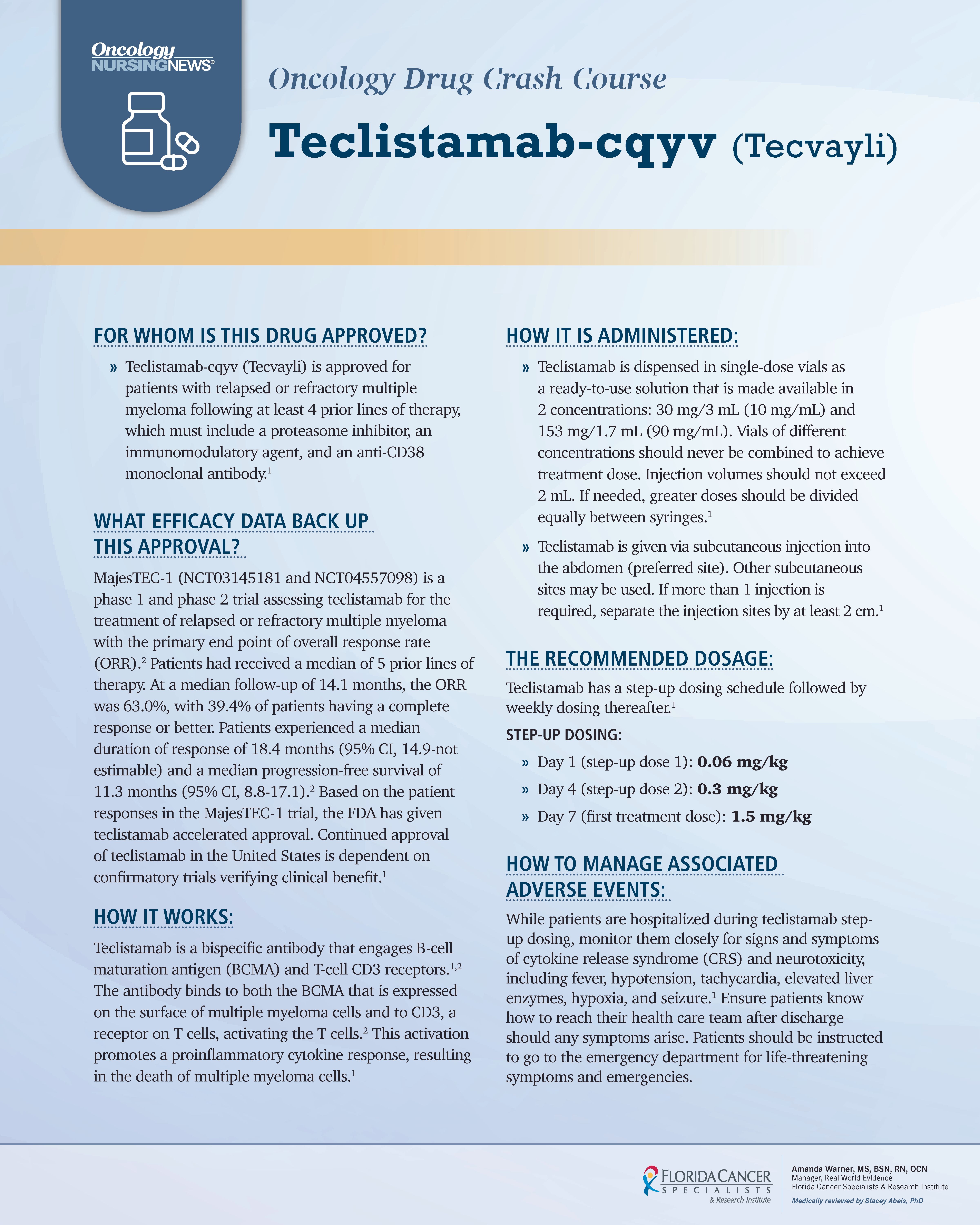Oncology Drug Crash Course: Teclistamab-cqyv (Tecvayli)
Amanda Warner, MS, BSN, RN, OCN, who is manager of research informatics & real world evidence with Florida Cancer Specialists & Research Institute, provides an in-depth look at teclistamab in a downloadable fact sheet.
For a downloadable version that you can print at home, check out our oncology drug crash course page.
For Whom Is This Drug Approved?
» Teclistamab-cqyv (Tecvayli) is approved for patients with relapsed or refractory multiple myeloma following at least 4 prior lines of therapy, which must include a proteasome inhibitor, an immunomodulatory agent, and an anti-CD38 monoclonal antibody.1
What Efficacy Data Back Up This Approval?
MajesTEC-1 (NCT03145181 and NCT04557098) is a phase 1 and phase 2 trial assessing teclistamab for the treatment of relapsed or refractory multiple myeloma with the primary end point of overall response rate (ORR).2 Patients had received a median of 5 prior lines of therapy. At a median follow-up of 14.1 months, the ORR was 63.0%, with 39.4% of patients having a complete response or better. Patients experienced a median duration of response of 18.4 months (95% CI, 14.9-not estimable) and a median progression-free survival of 11.3 months (95% CI, 8.8-17.1).2 Based on the patient responses in the MajesTEC-1 trial, the FDA has given teclistamab accelerated approval. Continued approval of teclistamab in the United States is dependent on confirmatory trials verifying clinical benefit.1
How it Works:
Teclistamab is a bispecific antibody that engages B-cell maturation antigen (BCMA) and T-cell CD3 receptors.1,2 The antibody binds to both the BCMA that is expressed on the surface of multiple myeloma cells and to CD3, a receptor on T cells, activating the T cells.2 This activation promotes a proinflammatory cytokine response, resulting in the death of multiple myeloma cells.1
How It Is Administered:
» Teclistamab is dispensed in single-dose vials as a ready-to-use solution that is made available in 2 concentrations: 30 mg/3 mL (10 mg/mL) and 153 mg/1.7 mL (90 mg/mL). Vials of different concentrations should never be combined to achieve treatment dose. Injection volumes should not exceed 2 mL. If needed, greater doses should be divided equally between syringes.1
» Teclistamab is given via subcutaneous injection into the abdomen (preferred site). Other subcutaneous sites may be used. If more than 1 injection is required, separate the injection sites by at least 2 cm.1
The recommended dosage:
Teclistamab has a step-up dosing schedule followed by weekly dosing thereafter.1
Step-Up Dosing:
» Day 1 (step-up dose 1): 0.06 mg/kg
» Day 4 (step-up dose 2): 0.3 mg/kg
» Day 7 (first treatment dose): 1.5 mg/kg
How to Manage Associated Adverse Events:
While patients are hospitalized during teclistamab step-up dosing, monitor them closely for signs and symptoms of cytokine release syndrome (CRS) and neurotoxicity, including fever, hypotension, tachycardia, elevated liver enzymes, hypoxia, and seizure.1 Ensure patients know how to reach their health care team after discharge should any symptoms arise. Patients should be instructed to go to the emergency department for life-threatening symptoms and emergencies.
At the first sign of CRS, if the patient is not hospitalized, assess the need for hospitalization and administer supportive care based on the severity of the symptoms. For signs of neurotoxicity, immediately assess the patient and provide supportive care based on severity. For both CRS and neurotoxicity, teclistamab should be held or permanently discontinued.1
Other adverse events that patients may experience on treatment include pyrexia, musculoskeletal pain, injection site reaction, fatigue, upper respiratory tract infection, headache, pneumonia, nausea, and diarrhea.1 Ensure the patient has antiemetics readily available at home and has been provided instructions on how to manage diarrhea and constipation. The patient should be provided education regarding neutropenia and increased risk of infection and best practices for infection prevention when neutropenic.
What to Inform Patients Who Are About to Start Treatment:
Patients should be hospitalized for 48 hours after each dose of teclistamab during the step-up dosing schedule and should not operate or drive heavy machinery during this time. Patients should be instructed to immediately report any signs or symptoms of CRS or neurotoxicity, including but not limited to headache, fever, chills, and feelings of numbness or tingling.1
Advice for Nurses Who Administer This Regimen:
The nurse should complete an assessment of the patient and review the results of the complete blood count (CBC), comprehensive metabolic panel (CMP), and vital signs, including temperature. The CBC, CMP, and signs of neurologic toxicity should be assessed and monitored throughout treatment.
Prescribers will need to enroll in the Tecvayli Risk Evaluation and Mitigation Strategy program and complete training. Prior to the first administration of teclistamab, the nurse should ensure that the patient has received a patient wallet card, and that the risks of CRS and neurologic toxicity have been reviewed with the patient. The patient should receive premedication including a corticosteroid (dexamethasone), antihistamine (diphenhydramine), and antipyretic (acetaminophen) prior to both step-up doses and first treatment dose to reduce the risk of CRS. Premedication prior to subsequent doses of teclistamab may be used as needed.1
How to Safely Handle This drug:
Allow teclistamab to warm up to room temperature for at least 15 minutes prior to withdrawing the appropriate dose. Use aseptic technique to prepare and administer the medication.1 As with all hazardous drugs, the Oncology Nursing Society guidelines state that nurses should wear a protective chemotherapy gown and double chemotherapy gloves.3
References
1. Tecvayli. Prescribing information. Janssen Biotech, Inc; 2022. Accessed August 11, 2023. bit.ly/3X13apv
2. Moreau P, Garfall AL, van de Donk NWCJ, et al. Teclistamab in relapsed or refractory multiple myeloma. N Engl J Med. 2022;387(6):495-505. doi:10.1056/nejmoa2203478
3. Toolkit for safe handling of hazardous drugs for nurses in oncology. Oncology Nursing Society. 2018. Accessed August 11, 2023. bit.ly/3qIfYVL
Shared Model of Care Post-HCT Offers Safe Follow-Up, Reduces Patient Burden
Published: March 19th 2025 | Updated: March 19th 2025Alternating post-HCT care between specialized facilities and local cancer centers produced noninferior non-relapse mortality and similar quality of life to usual care.




